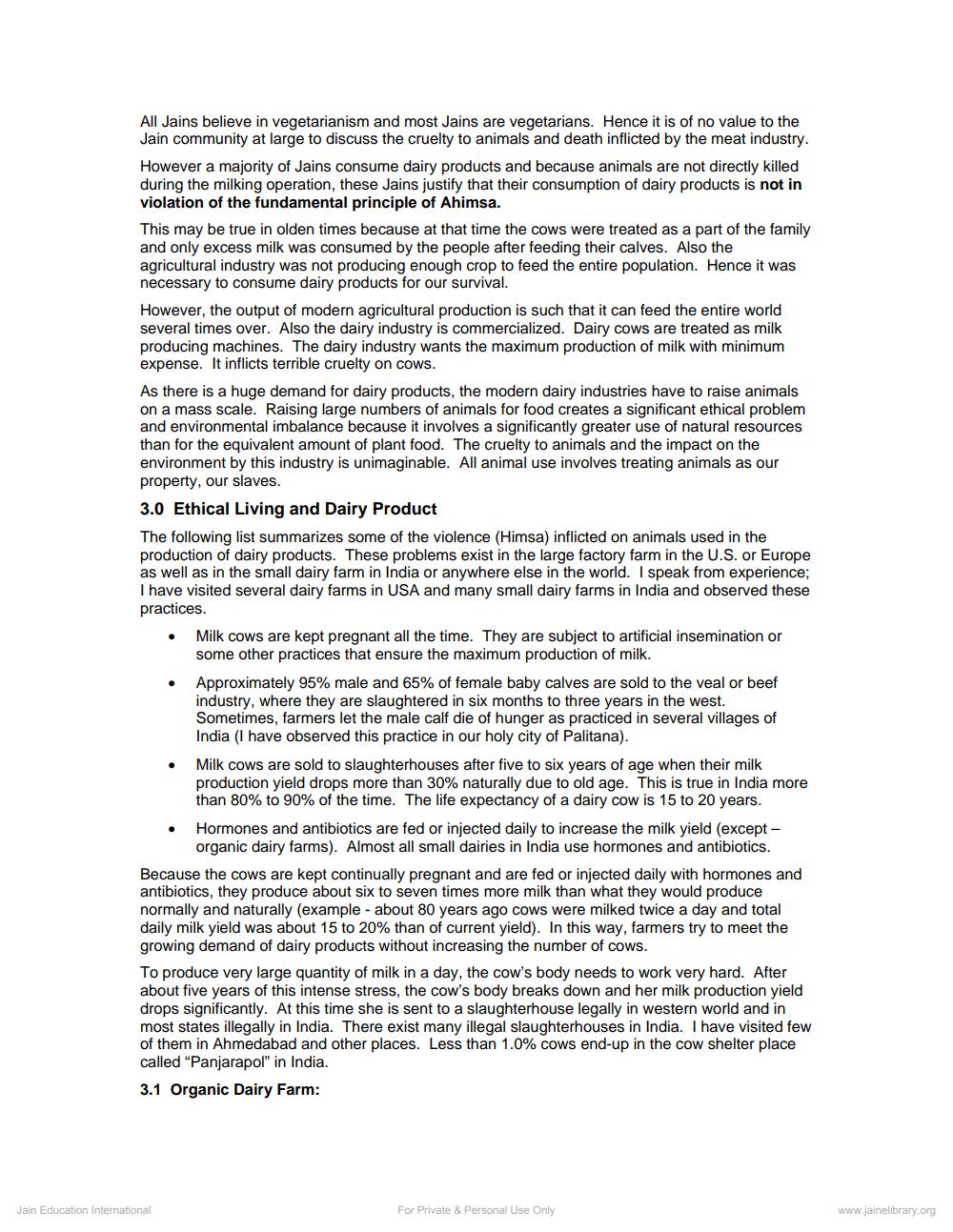Book Title: Jain Way of Life and Ethical Living and Environment Author(s): Pravin K Shah Publisher: JAINA Education Committee View full book textPage 2
________________ All Jains believe in vegetarianism and most Jains are vegetarians. Hence it is of no value to the Jain community at large to discuss the cruelty to animals and death inflicted by the meat industry. However a majority of Jains consume dairy products and because animals are not directly killed during the milking operation, these Jains justify that their consumption of dairy products is not in violation of the fundamental principle of Ahimsa. This may be true in olden times because at that time the cows were treated as a part of the family and only excess milk was consumed by the people after feeding their calves. Also the agricultural industry was not producing enough crop to feed the entire population. Hence it was necessary to consume dairy products for our survival. However, the output of modern agricultural production is such that it can feed the entire world several times over. Also the dairy industry is commercialized. Dairy cows are treated as milk producing machines. The dairy industry wants the maximum production of milk with minimum expense. It inflicts terrible cruelty on cows. As there is a huge demand for dairy products, the modern dairy industries have to raise animals on a mass scale. Raising large numbers of animals for food creates a significant ethical problem and environmental imbalance because it involves a significantly greater use of natural resources than for the equivalent amount of plant food. The cruelty to animals and the impact on the environment by this industry is unimaginable. All animal use involves treating animals as our property, our slaves. 3.0 Ethical Living and Dairy Product The following list summarizes some of the violence (Himsa) inflicted on animals used in the production of dairy products. These problems exist in the large factory farm in the U.S. or Europe as well as in the small dairy farm in India or anywhere else in the world. I speak from experience; I have visited several dairy farms in USA and many small dairy farms in India and observed these practices. Milk cows are kept pregnant all the time. They are subject to artificial insemination or some other practices that ensure the maximum production of milk. Approximately 95% male and 65% of female baby calves are sold to the veal or beef industry, where they are slaughtered in six months to three years in the west. Sometimes, farmers let the male calf die of hunger as practiced in several villages of India (I have observed this practice in our holy city of Palitana). Milk cows are sold to slaughterhouses after five to six years of age when their milk production yield drops more than 30% naturally due to old age. This is true in India more than 80% to 90% of the time. The life expectancy of a dairy cow is 15 to 20 years. Hormones and antibiotics are fed or injected daily to increase the milk yield (except - organic dairy farms). Almost all small dairies in India use hormones and antibiotics. Because the cows are kept continually pregnant and are fed or injected daily with hormones and antibiotics, they produce about six to seven times more milk than what they would produce normally and naturally (example - about 80 years ago cows were milked twice a day and total daily milk yield was about 15 to 20% than of current yield). In this way, farmers try to meet the growing demand of dairy products without increasing the number of cows. To produce very large quantity of milk in a day, the cow's body needs to work very hard. After about five years of this intense stress, the cow's body breaks down and her milk production yield drops significantly. At this time she is sent to a slaughterhouse legally in western world and in most states illegally in India. There exist many illegal slaughterhouses in India. I have visited few of them in Ahmedabad and other places. Less than 1.0% cows end-up in the cow shelter place called "Panjarapol" in India. 3.1 Organic Dairy Farm: Jain Education International For Private & Personal Use Only www.jainelibrary.orgPage Navigation
1 2 3 4
